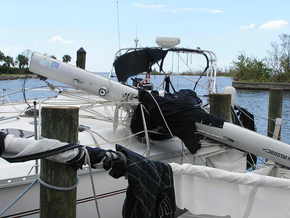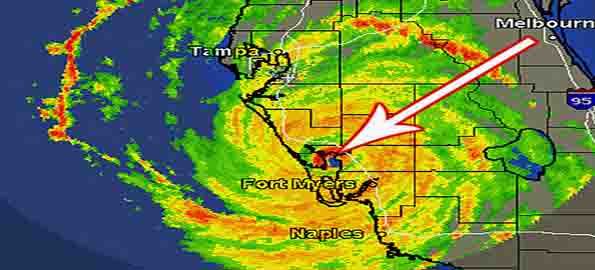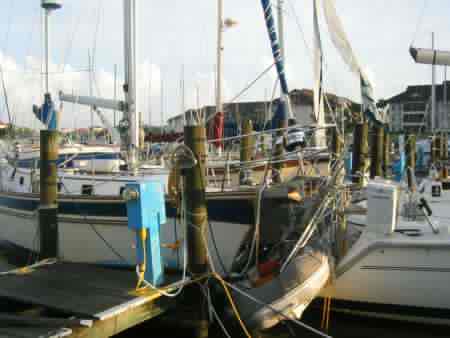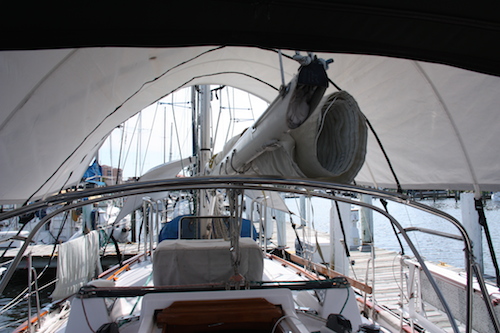Tomorrow, June 1, is the first day of hurricane season. Aaarrrggg… not again! But even though we dread having the boat back in the Atlantic hurricane zone, surviving a direct hit when Cat 4 Hurricane Charley paid an unexpected visit, made us realize the importance of advance preparation. I’ve compiled a few links, both mine and others, that may be of some help when you’re planning your hurricane preparations.
Boat Prep in a Marina
 Removing a Roller Furling Jib — in our experience the #1 MOST CRITICAL preparation for a hurricane is removing ALL the windage possible, all canvas … and this includes the roller furling jib. It is NOT sufficient to merely wrap extra lines around the jib and expect it to survive through a hurricane, too many times we’ve seen evidence to the contrary. You don’t want to risk a broken mast or other significant damage because the roller furling was left up! Here’s another post that may be useful – it’s actually devoted to putting the roller furling back on, but it’s a photo essay with more detail and doing the steps in reverse will help remove the roller furling jib.
Removing a Roller Furling Jib — in our experience the #1 MOST CRITICAL preparation for a hurricane is removing ALL the windage possible, all canvas … and this includes the roller furling jib. It is NOT sufficient to merely wrap extra lines around the jib and expect it to survive through a hurricane, too many times we’ve seen evidence to the contrary. You don’t want to risk a broken mast or other significant damage because the roller furling was left up! Here’s another post that may be useful – it’s actually devoted to putting the roller furling back on, but it’s a photo essay with more detail and doing the steps in reverse will help remove the roller furling jib.
10 Tips for Revisiting Dock Lines — after removing all the windage from the boat, we believe the next most critical step is the spiderweb of dock lines. When we leave the boat, we have double lines on everything to as many different pilings as possible — keep in mind, alot of the damage and sunken boats during Charley were due to pilings breaking. Also, try to anticipate what storm surge will do to the dock lines — will they float right off the top of the pilings? Or will they be too short and contribute to a piling breaking? It is SO hard to judge the right configuration. For Charley we had all our lines set for a serious storm surge .. then the hurricane sucked all the water OUT of the marina, leaving the boats sitting on the mud and when the predicted storm surge did come in, it started from mud, not from normal water levels. The wall of water forced the boats on the “outside” of the docks under the docks causing quite a bit of damage to bow sprits and stern rails. We were lucky in that we were on the “inside” of the dock where the storm surge pushed us away from the dock and minimized any damage. But try to visualize what might happen with a wall of water coming into the marina and configure your dock lines the best you can.
Chafe Gear? 4 Important Considerations for Your Boat — all the lines in the spiderweb won’t do a bit of good if they chafe through either at the boat or on the dock/pilings!
Hurricane Season … Are You Ready? — don’t forget all the other details .. if the boats are wildly rocking side to side, are you going to have masts get tangled with boats on either side of your slip? … don’t forget to shut off the power (or have your caretaker do it for you) … fenders, batteries, drains, bilge pumps, etc. The devil is often in the small details. Don’t risk sinking because of clogged drains!
After the Hurricane 10 tips for “hidden” things to check on after the hurricane.

Tracking a Hurricane
Unless you have no choice, never stay aboard during a hurricane. (See below for Carolyn’s links on being aboard at anchor for Hurricane Marty.) We sat through the remnants of Hurricane Mitch in a chartered 33′ sailboat in the Abacos and the “only” 60-70 mph winds were scary enough, I cannot image being aboard during a “real” hurricane!
Without Internet: Easy Hurricane Tracking Via SSB Note that this software must be installed while you still have internet access, but it allowed us to track Hurricane Ida via SSB as it formed 100 miles behind us from when we were sailing into Providencia, Colombia — here’s the link to that saga! The software magically takes the NOAA text and imports it into an easy visual where you can plot your boat’s location and get specific information on how close it may come to you as well as have confidence in the wind direction where you are.
Chris Parker’s Caribbean Weather Service. If you’re cruising an area covered by Chris Parker’s weather services, they will be very valuable, far beyond the annual subscription fees for “sponsoring vessels”. Keep in mind, you can still listen to the SSB nets for free, you just cannot ask questions or get the daily text updates without subscribing. When we’re cruising waters that Chris covers, we always subscribe.
Hurricane Tracker – IPhone/IPad App. We enjoy this $1.99 app for IPhone or IPad. It’s nothing more than a compilation of available hurricane data, but it’s easy and readily available if you’re in cell range.
Online. You can get the same info online at a variety of sources for free, just google and pick your favorite … mine is Weather Underground just because the info is compiled into one spot and easy to access. The National Hurricane Center from NOAA probably has the most extensive coverage (duh!) but I like having just the overview, too much detail gets me confused. 🙂

Hurricane Prep at Anchor
Hurricane Warning — Riding Out a Big Blow at Anchor. A comprehensive guide to riding out a hurricane at anchor based on Carolyn & Dave’s experience in Hurricane Marty — read the article over at TheBoatGalley.com.
Hurricane Preparation. In addition, Carolyn has many other very useful articles on preparing for a hurricane – she’s compiled a list of all the available articles at this link.
Have you found other links that are helpful for hurricane preparation? Please leave a comment and share. I’ll plan to add any new links to this list daily so it can be as comprehensive as possible. THANKS! Jan














If you have other hurricane preparation links that you find useful, please let me know & I’ll add them. It would be great to have a fairly extensive resource page. Thx!
[…] If you’re curious what this actually entails, take a peek over at two great resources here and here. […]
[…] referring back to some of our favorite resources on Commuter Cruiser and The Boat Galley here and here. Both Jan and Carolyn give some very helpful tips to keep in mind while preparing for a […]
[…] after reviewing some hurricane prep web links provided by Commuter Cruiser and other sources, we began to prepare for Joaquin’s potential wind […]